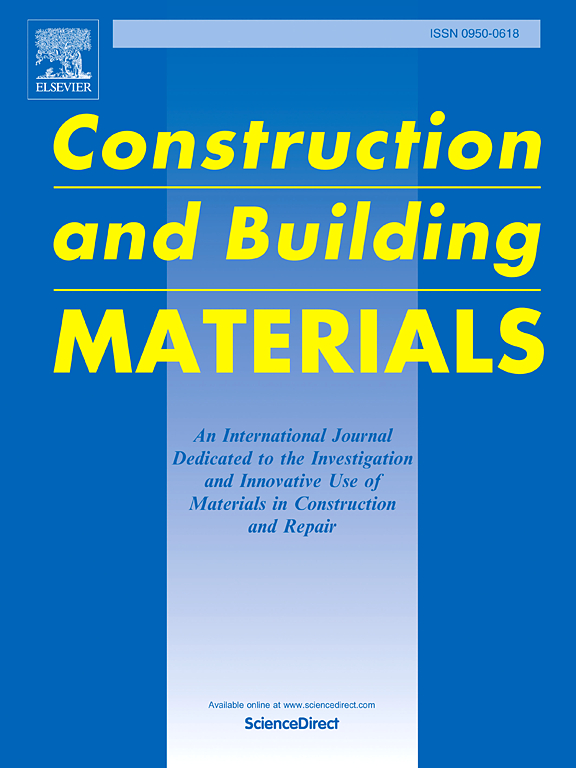Role of recycled crushed clay bricks as fine aggregates in enhancing the performance of ferrocement-strengthened RC beams
IF 7.4
1区 工程技术
Q1 CONSTRUCTION & BUILDING TECHNOLOGY
引用次数: 0
Abstract
Ferrocement is a highly effective composite material for enhancing damaged-reinforced concrete (RC) structural elements thanks to its excellent fracture resistance, tensile and flexural strength, crack resistance and durability. This material is applied in thin layers of cement mortar reinforced with steel wire mesh. The resulting structures are strong, lightweight, and cost-effective while allowing for incorporating recycled materials, promoting sustainability and environmental friendliness. Inspired by the outstanding performances of this technique, this study investigated 20 RC beams strengthened using ferrocement. Ferrocement mortar was fabricated with five various substitute rates (0–100 %, with 25 % incremental) of natural sand (NS) by recycled crushed clay brick (RCCB) and two water to cement ratios (w/c) of 0.30 and 0.50. Compressive, tensile, and flexural strength, and porosity of the mortar, were also investigated. In addition, a data-based model was developed and validated with experimental results. A significant enhancement in flexural resistance was recorded for the strengthened beam with up to 50 % RCCB than the unstrengthened beam-USB (15 % and 6 % for w/c of 0.30 and 0.50, respectively, higher than USB), which is aligned with the substantially higher mechanical strength and lower porosity of mortar. It was registered that the damaged beams strengthened with 50 % RCCB were able to nearly reach the stiffness of the USBs and deliver higher deflection (81 % and 31 % for a w/c of 0.30 and 0.50, respectively, higher than 100 % USB) with ductile failure induced by multiple flexural and diagonal cracks. The proposed data-based modelling achieved excellent results, accurately predicting the beams' load deflection and the mortar mixes' strengths and porosity.
再生破碎粘土砖细骨料对钢筋混凝土加固梁性能的提高作用
铁水泥具有优异的抗断裂、抗拉、抗弯强度、抗裂性和耐久性,是一种用于增强损伤钢筋混凝土(RC)结构构件的高效复合材料。这种材料应用于用钢丝网加固的薄层水泥砂浆中。由此产生的结构坚固,重量轻,成本效益高,同时允许纳入回收材料,促进可持续性和环境友好性。受该技术卓越性能的启发,本研究对20根钢筋混凝土梁进行了钢筋混凝土加固。采用再生破碎粘土砖(RCCB)天然砂(NS)的5种不同替代率(0-100 %,增量25 %),水灰比(w/c)分别为0.30和0.50配制铁水泥砂浆。抗压、抗拉和抗折强度以及砂浆的孔隙率也进行了研究。建立了基于数据的模型,并用实验结果进行了验证。结果表明,与未增强的USB相比,RCCB含量高达50% %的加固梁的抗弯性能显著增强(w/c分别为0.30和0.50时,RCCB含量分别为15 %和6 %,高于USB),这与砂浆具有更高的机械强度和更低的孔隙率一致。结果表明,使用50 % RCCB加固的受损梁能够接近USBs的刚度,并且具有更高的挠度(w/c分别为0.30和0.50时,分别高于100 % USB,分别为81 %和31 %),并且具有多重弯曲和对角裂纹引起的延性破坏。所提出的基于数据的建模取得了优异的结果,准确地预测了梁的荷载挠度和砂浆混合料的强度和孔隙率。
本文章由计算机程序翻译,如有差异,请以英文原文为准。
求助全文
约1分钟内获得全文
求助全文
来源期刊

Construction and Building Materials
工程技术-材料科学:综合
CiteScore
13.80
自引率
21.60%
发文量
3632
审稿时长
82 days
期刊介绍:
Construction and Building Materials offers an international platform for sharing innovative and original research and development in the realm of construction and building materials, along with their practical applications in new projects and repair practices. The journal publishes a diverse array of pioneering research and application papers, detailing laboratory investigations and, to a limited extent, numerical analyses or reports on full-scale projects. Multi-part papers are discouraged.
Additionally, Construction and Building Materials features comprehensive case studies and insightful review articles that contribute to new insights in the field. Our focus is on papers related to construction materials, excluding those on structural engineering, geotechnics, and unbound highway layers. Covered materials and technologies encompass cement, concrete reinforcement, bricks and mortars, additives, corrosion technology, ceramics, timber, steel, polymers, glass fibers, recycled materials, bamboo, rammed earth, non-conventional building materials, bituminous materials, and applications in railway materials.
 求助内容:
求助内容: 应助结果提醒方式:
应助结果提醒方式:


